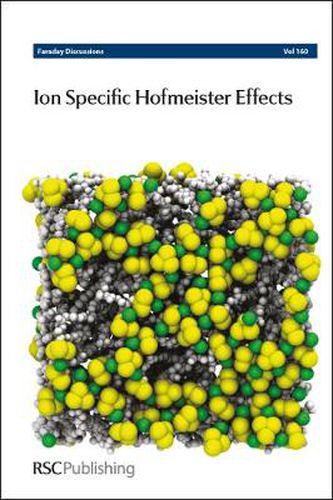Readings Newsletter
Become a Readings Member to make your shopping experience even easier.
Sign in or sign up for free!
You’re not far away from qualifying for FREE standard shipping within Australia
You’ve qualified for FREE standard shipping within Australia
The cart is loading…






The hydration of ions and the interactions of ions with (bio)molecules play a key role in many natural and technological processes. These effects are usually framed in terms of the lyotropic or Hofmeister series which traditionally orders cations and anions according to their ability to salt-out proteins. Since its formulation more than one hundred years ago, the lyotropic series has been invoked in myriad effects including the crystallization of proteins, enzyme activities, the swelling of tissues, salt solubilities, ion exchange, surface tension of electrolytes, and bubble coalescence.
Although it is now clear that the Hofmeister series is intimately connected with ion hydration in homogeneous and heterogeneous environments and with ion pairing, the molecular origin of these effects has been poorly understood. Biochemists and physical chemists have been typically using the term Hofmeister series to put a label on ion specific behaviour in various environments, rather than to reach a molecular level understanding and, consequently, an ability to predict a particular effect of a specific salt ion.
This meeting (which took place at Queen’s College Oxford in September 2012) aimed to respond to the emerging situation in which science has matured enough to be able to provide answers about the molecular nature of ion specific effects. It explored the most important issues in understanding the chemistry and biological effects of ions, with state of the art work being presented using advanced experimental and computational methods.
Investigation of ion specific effects is truly interdisciplinary since it requires chemists, biochemists, and biophysicists to collaborate with each other, combining experimental and computational approaches. We invited researchers in these fields to take part in the Discussion and join the chosen speakers who are among the key scientists behind the recent renaissance of interest in ion specific effects.
Themes covered included:
Solvation of ions in the aqueous bulk and at interfaces Ion-ion interactions in water Interactions between ions and biomolecules (proteins, nucleic acids, membranes, etc.) in water. Specific Hofmeister effects of ions and osmolytes on protein association, precipitation, folding/unfolding, and activity
$9.00 standard shipping within Australia
FREE standard shipping within Australia for orders over $100.00
Express & International shipping calculated at checkout
The hydration of ions and the interactions of ions with (bio)molecules play a key role in many natural and technological processes. These effects are usually framed in terms of the lyotropic or Hofmeister series which traditionally orders cations and anions according to their ability to salt-out proteins. Since its formulation more than one hundred years ago, the lyotropic series has been invoked in myriad effects including the crystallization of proteins, enzyme activities, the swelling of tissues, salt solubilities, ion exchange, surface tension of electrolytes, and bubble coalescence.
Although it is now clear that the Hofmeister series is intimately connected with ion hydration in homogeneous and heterogeneous environments and with ion pairing, the molecular origin of these effects has been poorly understood. Biochemists and physical chemists have been typically using the term Hofmeister series to put a label on ion specific behaviour in various environments, rather than to reach a molecular level understanding and, consequently, an ability to predict a particular effect of a specific salt ion.
This meeting (which took place at Queen’s College Oxford in September 2012) aimed to respond to the emerging situation in which science has matured enough to be able to provide answers about the molecular nature of ion specific effects. It explored the most important issues in understanding the chemistry and biological effects of ions, with state of the art work being presented using advanced experimental and computational methods.
Investigation of ion specific effects is truly interdisciplinary since it requires chemists, biochemists, and biophysicists to collaborate with each other, combining experimental and computational approaches. We invited researchers in these fields to take part in the Discussion and join the chosen speakers who are among the key scientists behind the recent renaissance of interest in ion specific effects.
Themes covered included:
Solvation of ions in the aqueous bulk and at interfaces Ion-ion interactions in water Interactions between ions and biomolecules (proteins, nucleic acids, membranes, etc.) in water. Specific Hofmeister effects of ions and osmolytes on protein association, precipitation, folding/unfolding, and activity